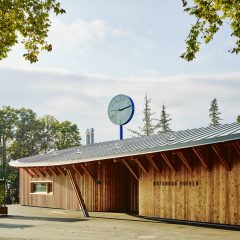The small village of Vals has provided itself with another powerful architectural work in the form of a stone clad concrete bridge. While its striking appearance is compounded by its large size and heft in relation to its surroundings, it is crossing the bridge by foot that one experiences its most remarkable features.
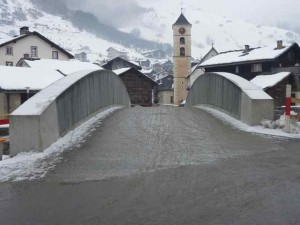
The new asymmetrical bridge replaces a light steel bridge dating from the 1920s. The bridge’s 80-foot steeply arced span springs out from a tight convergence of main road, houses, mountainside and river. It aims just to the left of the village church and fountain and drops you onto the small hill leading down into the snug, low lying, house-lined main square of the village.

When you first arrive at the bridge after your long journey ( because Vals is far from everywhere) you glimpse the bodily and spiritual refreshment awaiting you just a few steps away on the other side. But prepare to be transported elsewhere in the interval. As you cross, the walls curve high above your head, obliterating all of the usual visual experiences associated with crossing a bridge. You can’t see or hear the water. The vistas carved by running water are eclipsed and you can’t watch the trout swimming in your shadow. Once you are in mid-span you can stop. There is never much traffic. You are now somewhere deep inside of the bridge as if in a tunnel or in a room or on some kind of observation deck, observing your isolation from the danger flowing beneath your feet. Its massiveness girdles you like a battleship. You hit a comfort zone in the hands of strength and safety. For some, though, being cut off from the water and the pleasures of being suspended over it makes the experience analogous to crossing the river stuck inside of a giant rubber boot.
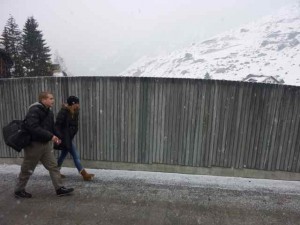
For centuries the Valsers lived in fear of the elements, especially water. When they weren’t being crushed by avalanches they were being flooded by the river. Mastering, exploiting and respecting the elements has been their creed, and this bridge embodies their will to stand up to the elements with stone and engineering. Form and spirit combine to make this arch appear to be a natural shape hewn out of stone by erosive forces.
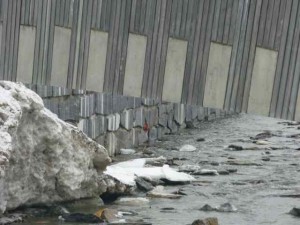
The architect Jurg Conzett is an engineer and former Peter Zumthor employee. He has riffed in the bridge architecture on the same long, thin granite slabs-stacked-like-bricks construction of the Zumthor /Vals Thermal Baths, in the engineering of which he was also involved. In the bridge, thin granite slabs are arranged vertically like a hand fan at 90 degrees to the street.
Curiously everyone who sees the bridge, or any other major works in town, assumes that it is a Zumthor creation. The fame of the Baths is so great and widespread that a boomerang effect has made Vals into a sort of Zumthorville. I asked a member of staff at the town hall if there were some kind of Master Plan for transforming the village to which he replied ‘No! This is a democracy!” Then he showed me the Zumthor plans for transforming the dusty and gritty asphalt mountain road by which we came to Vals into a newly stone-paved black-and-white walk and drive way. . . in the spirit of the Yellow Brick Road? Who’s the Wicked Witch of the East then? And who would be Wizard?
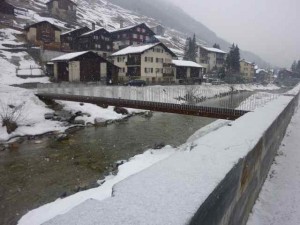
It wasn’t until the advent of the baths that any architects worked in Vals. Before then buildings were constructed in the local idiom which included specific granite roof tiling. A builder absorbed this language (no women builders I’m afraid) while learning to build. Today regional architects expand the local idioms. Their objects have clear origins, as witnessed in the barns dotting the hillsides.
No matter what architect holds the reins future construction in the village will be the combined result of the needs, will and vision of the people (as persuaded by smooth talk of course) and resolutely modern/traditional ( or “motrad”) structures with only frugal adornment.
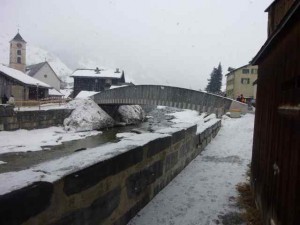
I don’t know how hard it was to have democracy cross this hefty bridge when it came to it. But just one step onto it confirms that it is lithe like an athlete and its structural dexterity enables us to step briefly into a zone of weightlessness at its apex. Crossing this bridge is a short but remarkable trip.





